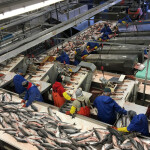A 15-year recovery plan to improve the state of the highly valuable but at-risk Mediterranean swordfish stock was adopted by the International Commission for the Conservation of Atlantic Tunas (ICCAT) at its 20th Special Meeting, which was held in Vilamoura, Portugal, on 14 to 21 November.
Following a proposal tabled by the European Commission (EC) amid concerns about the species’ current rate of depletion, ICCAT contracting parties agreed on a catch limit of 10,500 metric tons (MT) next year and a gradual reduction of 15 percent over the subsequent five years – from 10,185 MT in 2018 to 8,925 MT in 2022.
The plan has been widely welcomed, with the E.U. Commissioner for Maritime Affairs and Fisheries, Karmeu Vella, voicing his pleasure that all Mediterranean countries had agreed to address the “dire situation” by accepting to limit and gradually reduce their swordfish catches alongside a package of other measures.
“Bringing back this emblematic species to sustainable levels will benefit many fishermen, including the small scale fleets,” said Vella.
But there are also trepidations about whether the plan is dynamic enough, particularly as earlier this year the ICCAT scientific committee (SCRS) recommended an immediate and substantial reduction in Mediterranean swordfish catches, which are estimated to include up to 70 percent of juveniles.
WWF said that with stocks of this iconic species being overfished for 30 years, ICCAT’s move is an essential first step but much remains to be done.
In the long-term, the recovery plan should help secure a future of the swordfish fishery and the communities in the region that depend on it,” said Giuseppe Di Carlo, director of WWF's Mediterranean Marine Initiative.
But he added that concerns remain because the quota agreed for 2017 will be higher than the catches reported in 2015, when the species was already highly overfished.
“It is now crucial that ICCAT's contracting parties fully implement control, monitoring and traceability measures and cooperate with scientists to conduct a robust stock assessment and ensure a new definition of the minimum size to protect juveniles,” he said.
Also at the meeting, ICCAT contracting parties adopted for the first time a catch limit for the blue shark stock in the North Atlantic, which was set at 39,102 MT and could provide the basis for a multi-annual plan for the fishery to ensure the long-term sustainability of the species.
In total, ICCAT approved 19 new recommendations and five resolutions.
The commission’s scientists and managers have also planned a demanding agenda for 2017 with the scheduling of 13 scientific meetings and seven Intersessional Commission meetings. The outcomes of these meetings will be the basis for deliberations at the next annual meeting, which will be held in Marrakech, 13-20 November 2017.






